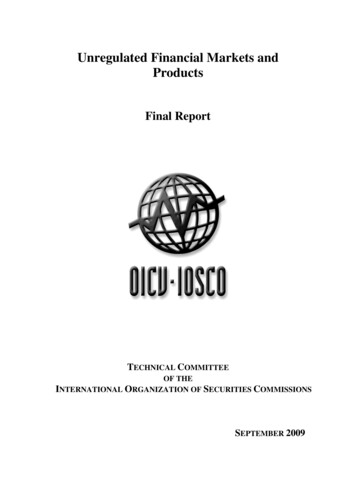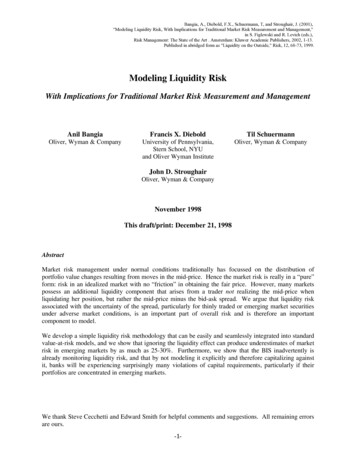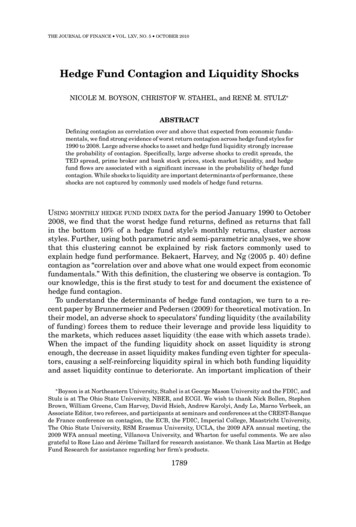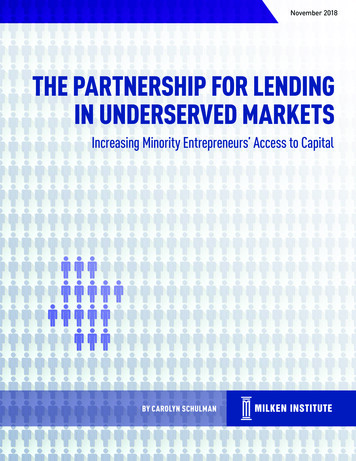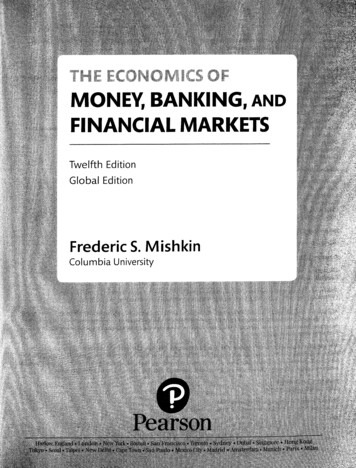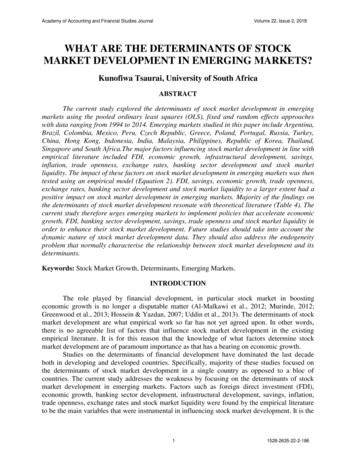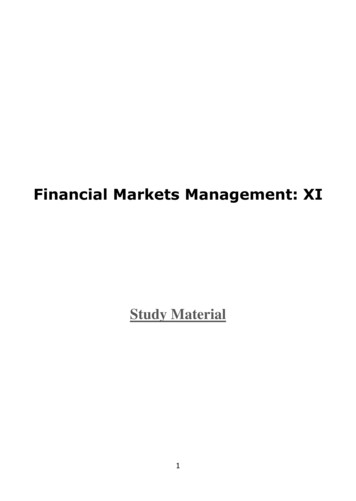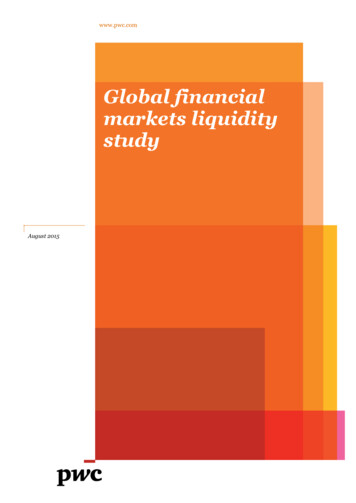
Transcription
www.pwc.comGlobal financialmarkets liquiditystudyAugust 2015
Global financial markets liquidity studyContentsImportant noticeExecutive summary123468Introduction14Purpose of this study14Rising liquidity concerns14Our approach16Structure of this report16What is liquidity?17Dimensions of liquidity17The benefits of financial markets liquidity19How is liquidity provided?20The role of market makers21Differences in liquidity across markets23When liquidity dries up28Excess money supply29Broader factors affecting market liquidity29Impact of current financial sector regulations on financial markets liquidity35Capital and liquidity requirements36Market infrastructure and transparency40Structural reforms45Recovery and resolution48Taxes and levies50Aggregate reform impact50Financial markets liquidity51Rates51Credit60Securitisation75Foreign exchange77Commodities84Equities87Emerging markets5596Summary102Overall assessment104Drivers of future financial markets liquidity105Continued banking sector and capital markets regulation105Increase in the size of financial markets109Impact of electronic trading platforms111Impact of new and different market participants113Policy considerations117Introduction117Policy considerations117Appendices121
Global financial markets liquidity studyAppendicesAppendix A:Glossary122Appendix B:Bibliography124Appendix C:Review of regulations affecting liquidity135Appendix D:Summary of impacts of regulations on liquidity142Appendix E:Summary of other studies144Appendix F:Methodology for assessing liquidity impacts in corporate bond markets149
Global financial markets liquidity studyImportant noticeImportant message to readers who are not addresseesBy reading this report you accept and agree to the following terms:1.The reader of this report acknowledges and understands that the work performed byPricewaterhouseCoopers LLP was performed in accordance with our contract with our addressee clientand was performed exclusively for our addressee client’s sole benefit and use.2.The reader of this report acknowledges that this report was prepared at the direction of our addresseeclient and may not include all procedures deemed necessary for the purposes of the reader.3.The reader agrees that PricewaterhouseCoopers LLP, its partners, principals, employees and agentsneither owe nor accept any duty or responsibility to it, whether in contract or in tort (including withoutlimitation, negligence and breach of statutory duty), and shall not be liable in respect of any loss, damageor expense of whatsoever nature which is caused by any use the reader may choose to make of this report,or which is otherwise consequent upon the gaining of access to the report by the reader. Further, thereader agrees that this report is not to be referred to or quoted, in whole or in part, in any prospectus,registration statement, offering circular, public filing, loan, other agreement or document.PwCPage 5 of 152
Global financial markets liquidity studySynopsisMarket liquidity is critical to effective market functioning. Liquidity in financial markets facilitates theefficient allocation of economic resources through the productive allocation of capital and risk, theaccurate generation and dissemination of issuer-specific information, and the effectiveness of monetarypolicy and financial stability. The current market evidence points to a measurable reduction in financialmarket liquidity. For instance, European corporate bond trading volumes have declined by up to 45%between 2010 and 2015. Evidence suggests that large trades are becoming more difficult to execute withoutaffecting prices, with market participants breaking up larger trades into smaller tranches. There have beenmeasurable reductions in banks’ trading capacity: banks’ holdings of trading assets have decreased bymore than 40% between 2008 and 2015, and dealer inventories of corporate bonds in the US have declinedby almost 60% over the same period. This has accompanied a decline in turnover ratios in corporate bondmarkets, where trading volumes have failed to keep pace with the increase in issuance.The reduced liquidity observed is a product of multiple factors, including but not limited to banks derisking in the wake of the crisis (selectively de-leveraging and unwinding large non-performing andcapital-intensive credit books), following the introduction of new regulatory risk frameworks.This report explains the important role and underlying economics of market-making. Post-crisis, bankshave substantially strengthened their balance sheets (global banks’ equity levels have increased by around68% between 2006 and 2013); improved their ability to measure and price risk; and introduced businessmodels that are more closely aligned to serving client investment needs. Unlike other market participants,bank dealers are uniquely designed to provide clients services that require principal risk taking. Thisfunction is a vital element of market resilience during volatile events. The report describes the positivetransition that global markets are making in reaction to new market forces, including increasedelectronification and new entrants in providing core services to support the real economy. Such diversity isa necessary and welcome development, and complements the role banks and bank dealers will continue toplay in effective market functioning.In analysing the new market dynamics, including the effects that market-based and prudential regulationsare having on market liquidity, this report provides an analysis of specific regulatory initiatives that arepresenting challenges for banks’ traditional role as market makers. These substantial challenges impact theability of bank dealers to facilitate liquidity and the redistribution of risk in times of volatility, potentiallyintroducing new and unforeseen risks to our markets and economy.The report tries to weigh the costs and benefits of regulation, and identify those regulatory initiatives thatin aggregate, could have greater adverse impacts on market liquidity than may have been was envisagedwhen designed individually, especially when the interactions of market-based and prudential regulationson market participants are considered. Despite the reduction in dealer liquidity, markets have continued totrade. Corporate and sovereign bond issuance continues apace, particularly in the United States. Thus, thewithdrawal of dealer liquidity to date has not caused measurable economic damage. This is due to tworeasons. First, market participants have adjusted to this reality by trading less frequently and in smallerbatches. Second, current market conditions (quantitative easing and extraordinary monetary policy) arereducing liquidity pressures.A key question raised by this report is how sanguine market participants, policymakers and economistsshould be about this current state of affairs. Even if one assumes that markets would adjust to a world withlimited dealer liquidity, and where new entrants and trading technology bring together borrowers andsavers, the role of principal risk takers will continue to serve a unique and important role in financialmarkets. End-users have raised concerns about whether liquidity from other market sources will fullycompensate for the loss of dealers’ market-making capacity, and whether such an adjustment could havesubstantial costs for issuers and investors and economic growth and jobs more broadly.Thus, the study concludes that current and future market liquidity is a subject of concern for marketparticipants. It further finds that there are grounds for a review of the calibration of the reforms to dateand the ongoing regulatory agenda, in order to properly understand and consider the effects of regulatoryinitiatives on market liquidity by asset class, and to consider whether upcoming regulatory initiatives couldlikely exacerbate the trends in liquidity.PwCPage 7 of 152
Global financial markets liquidity studyExecutive summaryIntroductionThere have been numerous studies and reports to datethat offer valuable insights into the topic of marketliquidity. These reports, however, often focus on aparticular market or a specific regulation and as such,the aggregate impacts of recent regulations on marketliquidity are not well understood.With increasing concerns being voiced on the farreaching impacts of regulatory developments on marketliquidity, including from their bank members, theGlobal Financial Markets Association (GFMA) and theInstitute of International Finance (IIF) commissionedPwC to undertake a broad review of global financialmarkets liquidity.This study summarises our findings. It does notnecessarily represent the views of GFMA or IIFmembers, but rather, focuses on a review of financialmarkets liquidity using available data. We also spoke tofinancial market participants to interpret and validatethe findings from the market data and gather views onfuture trends.Importance of liquidity in financial markets“Liquidity appears to have becomeincreasingly brittle Although liquidityin these markets looks adequate duringnormal conditions, it seems to disappearabruptly during episodes of marketstress”Richard Berner, Director of the Office of Financial Research,Speech at the Brookings Institution, 8 June 2015“There is evidence that liquidity in somekey markets has become more fragile”Clara Furse, Bank of EnglandSpeech titled “Liquidity matters”, 11 February 2015“Market liquidity is structurally lowernow than it was in the past This willquickly become apparent in a downmarket.”Guy Debelle, Assistant Governor of the Reserve Bank of Australia,Speech at Citi’s 6th Annual Australian and New Zealand InvestmentConference, Sydney, 14 October 2014“Market adjustments to date haveoccurred without significant stress.However the risk of a sharp anddisorderly reversal remains given thecompressed credit and liquidity riskpremia.”Liquidity is a multi-dimensional concept, generallyreferring to the ability to execute large transactions withMark Carney, Chairman of the Financial Stability Board (FSB)limited price impact, and tends to be associated with“Carney says see risk of disorderly unwinding of portfolios”low transaction costs and immediacy in execution.Reuters, 26 March 2015While some market practitioners question whetherliquidity can be adequately defined, we consider there are various aspects of liquidity that can be measured andstudied. In particular we focus on the four attributes of: (i) immediacy; (ii) market depth and resilience, (iii)market breadth and (iv) tightness.We consider liquidity to be important for effective market functioning. Liquidity in financial markets facilitatesthe efficient allocation of economic resources through the efficient allocation of capital and risk, the effectivegeneration and dissemination of issuer-specific information, and the effectiveness of monetary policy andfinancial stability. The financial crisis demonstrated the advantages of having a robust financial system which isable to absorb unpredictable shocks, while maintaining market-wide liquidity. We consider market liquidity tobe invariably beneficial.In some markets such as fixed income and bespoke derivative instruments where matching supply and demandfor a given instrument becomes more challenging, market makers, such as banks and trading firms are essentialin providing liquidity and facilitating transactions by stepping in as counterparties to such transactions. Thisinvolves buying or selling financial instruments without an immediate matching transaction and it requiresmarket makers to bear risks relating to the movement in inventory values.Liquidity conditions can differ significantly across different asset classes, even in normal times. Financial assetswith lower levels of liquidity tend to have higher liquidity risk premia, and market participants also tend to facehigher transaction costs and wider bid-ask spreads when trading in these instruments. Properly pricingliquidity risk premia is a positive result of post-crisis reforms, which helps to decrease the risks of rapid growthPwCPage 8 of 152
Global financial markets liquidity studyin instruments where there is little understanding of the underlying risks. However, a lack of liquidity for someasset classes has a very real cost to the end-users of financial markets and the report identifies where these costsmay outweigh the benefits of new market developments.We consider there are at least five broad trends driving global market liquidity conditions at the moment. Theseinclude: (i) stable and supportive global monetary conditions, which support overall liquidity throughout theeconomy; (ii) the increase in electronification and digitalisation in financial markets, which helps reduce thecosts of trading and links up buyers and sellers; and (iii) the growing engagement of providers of alternativemarket-based financing in some aspects of market-making. Countering these three trends are: (iv) the overallincrease in the size of financial markets and associated demand for liquidity; (v) the reduced supply of dealermarket-making capacity, which is driven by regulatory reforms in the financial sector; and a diminished riskappetite across banks as they adjust to a post-crisis market environment.The findings from our study suggest an early-warning signal, in that Quantitative Easing (QE) programmes andthe global economic and monetary environment have been generally favourable to market functioning.However, following the unwinding of QE or in a stressed environment, liquidity risks and market fragilities arelikely to be revealed, potentially resulting in higher volatility in financial markets and increased pressure oncorporates and investors to manage risks and adjust their portfolios. At this point, the role of alternative marketbased finance providers (algorithmic and high frequency traders, hedge funds) as resilient providers of liquiditywill be tested. These providers are not likely, in the short- to medium term, to be sufficient to fully replace thecurrent and potential additional loss of market-making capacity and trading activity from dealers.Impact of regulatory reforms on financial marketsWe have identified five broad ways in which regulatory reforms have impacted or will impact financial marketsactivity: PwCBank deleveraging, refocusing and exits. As banks respond to the new regulatory environment,they have sought to make more efficient use of capital and liquidity resources, by reducing the marketsthey serve and streamlining their operations.Reduction in market-making activity. Capital and funding intensive areas such as market makingin fixed income, credit, derivatives and commodities have been particularly impacted. This can lead to areduction in liquidity in those dealer-led markets where market making provides a key source ofliquidity. Our analysis shows that changes in capital and liquidity regulation have greatly increased bothcapital charges across banks’ business areas (see Figure 1) and the cost of financing those businesses. Theincreases are more pronounced in commodities, securitisation and credit. Our analysis of the evolution ofglobal banks’ balance sheets suggests that business lines that are either low-risk, but impacted by thenon-risk-based leverage capital ratios (such as sovereign and investment-grade bonds); or business linesthat have experienced a relative increase in capital intensity, were the ones more likely to experiencehigher levels of deleveraging (see Figure 2). This is consistent with our finding of a decline in the numberof market makers active in European corporate bond markets.Page 9 of 152
Global financial markets liquidity studyFigure 1: Changes in risk-weighted capitalcharges due to changes in the Basel capitalregimeRWA/asset ratio% change in assetsbetween 2011 and 2014350%Figure 2: Degree of deleveraging (reduction inassets) in relation to change in risk-weightedcapital charges by area of capital marketsactivity (2011 prepared on a pre-Basel 2.5 basis)300%250%200%150%100%50%Basel 2.5 (2011)Source: PwC analysis, Tricumen Basel 2.5 Equities60%40%20%FX0%-50%0% 80%0%Change in risk-weighted capitalcharges between 2011 and 2014,percentage tiesRates-60%CreditBasel 3 (2014)-80%Source: PwC analysis, TricumenShifts in trading patterns, as characterised by the move towards central clearing and electronictrading platforms. While the shift in trading patterns as a consequence of new regulatory rules mayimprove liquidity for standardised, centrally cleared trades, it will reduce liquidity for those OTCinstruments that are not suited to central clearing or trade reporting (e.g. corporate bonds, OTCderivatives such as infrastructure financing hedging, embedded floors in insurance policies etc.), but areused frequently by investors and corporations.Liquidity contraction in repo markets. With outstanding balances in repo and other bank fundingmarkets falling, the contraction in repo markets has impacted liquidity provision by market makersacross other capital markets.Increased demand for and hoarding of liquid assets. Liquidity rules and collateral requirementsincrease the need for banks to hold high quality liquid assets, which, reduces their availability to supportother transactions, including repos. The lack of available high quality collateral can have a significantimpact on liquidity in secured markets, especially during a stressed environment. Prudential rules havealso materially increased the cost of holding less liquid assets, further increasing the demand for liquidassets.Decline in market liquidityOur study finds specific areas where market liquidity has declined, and warning signs that more significantdeclines may be masked by other factors. These include: PwCDifficulties in executing trades: Market participants are still generally able to execute the trades theyrequire, but the time taken and effort required to execute both with dealers and across multiple platformshas increased.Reduction in market depth: There are signs of declining depth and immediacy in capital markets ascharacterised by falling transaction sizes. Some price impact measures also show that smaller tradingvolumes are now moving market pricing by larger amounts. The ratios of trading to the size of markets(turnover ratios) for both corporate and sovereign bonds are on the decline (see Figures 3 and 4) astrading volumes have failed to keep pace with an increase in issuance.Page 10 of 152
Global financial markets liquidity studyFigure 3: Sovereign bond turnover ratios(average daily volumes/outstanding volumes)Figure 4: Corporate bond turnover ratios(average daily volumes/outstanding volumes)0.7%0.40%USEurope, 2.0%0.0%0.0%20102011Asia2012Europe20132014US (RH rce: Asian Development Bank, Trax, SIFMA, PwC analysis Increase in volatility: There is evidence that episodes of market correction and volatility are nowrising, after falling considerably since the global financial crisis. Volatility in bond markets in 2015 isaround 40% higher than in 2014. Whereas current market volatility is not as high as the extreme levels ofvolatility witnessed during the global financial crisis, volatility is arguably above historical levels duringbenign economic conditions.Bifurcation in liquidity: There is market evidence to suggest that a “bifurcation” is taking place acrosssome markets. Liquidity is increasingly concentrating in the more liquid instruments and falling in lessliquid assets. Areas of financial markets which have seen particular declines include longer dated FXforward contracts, some aspects of the high yield debt market and the single name CDS market. Liquidityreduction is not solely confined to less liquid areas, as even traditionally liquid sovereign debt marketshave experienced liquidity shortages.Outlook for liquidityThere are countervailing developments affecting the outlook for market liquidity. On the one hand, there arepending or planned rules that are likely to reduce market liquidity still further: regulations yet to beimplemented, such as the Fundamental Review of the Trading Book (FRTB), Markets in Financial InstrumentsDirective and Regulation (MiFID II and MiFIR), EU bank structural reform and the proposed financialtransaction tax (FTT), if inappropriately calibrated, will have a significant impact on the viability of banks’market-making activities and increase transaction costs for capital markets participants. The recently adoptedG-SIB surcharge in the United States, in which four of the five factors that determine the surcharge are drivenexclusively by capital markets behaviour, is certain to reduce market liquidity further. Any incorporation of a GSIB surcharge into the Federal Reserve’s CCAR would exacerbate this effect.On the other hand, there are three developments that could improve financial markets liquidity in a sub-set ofasset classes. First, the growth of exchange-traded funds (ETFs) provides investors with a more tradeableinstrument for investment, in the absence of directly investing in the underlying asset, which may not be asliquid. Second, more widespread adoption of electronic trading could further reduce transaction costs formarket participants by providing additional platforms to match buyers and sellers. Such platforms will, in somecases, help reduce the time required to locate buyers and sellers and improve the process of price discovery.Although electronic trading platforms have seen growth in recent years, they do not fully replace liquidityprovision by dealers, in particular the ability to bear proprietary risk and thereby provide immediacy. Theremay also be structural limits to their adoption, particularly in markets with a large number of differentinstruments traded, such as corporate credit and certain derivatives. Lastly, the partial retreat of banks fromsome financial markets has also been accompanied by the entrance or growth of other market participantstaking on some principal risk-taking activities.PwCPage 11 of 152
Global financial markets liquidity studyIn summary, the entry and growth of other market participants increases the diversity of market participants,the range of trading strategies employed, and facilitates market functioning by providing additional tradingactivity and market linkage. However, the collective impact of these three developments and other behaviouraladaptations is not likely, in the short- to medium term, to be sufficient to fully replace the current and potentialadditional loss of market-making capacity and trading activity from dealers. Also, it raises questions of whethernew market entrants have the necessary risk frameworks to support the new services.Policy considerationsIn any study of this kind, the empirical data is of course capable of different interpretations particularly as todetailed cause and effect. But we think three things come out very clearly. First, market liquidity plays anabsolutely crucial role in facilitating the efficient and stable functioning of markets and, by extension,economies. Second, the weight of empirical evidence does support a hypothesis that markets are less liquid.Third, for these reasons, the ongoing policy agenda should set the preservation or indeed restoration of marketliquidity as a high priority.Our study highlights the importance of the role played by market makers in providing liquidity, which hasdiminished since the global financial crisis as the balance sheet capacity of market makers has fallen. This hasled to reduced market depth. The implementation of further reforms are also likely to have significantimplications for future market liquidity.We recognise that there are substantial benefits to the range of banking sector regulations which have now beenimplemented, in the form of a lower probability and impact of future banking crises.We also note that regulation is not the only driver of reduced markets liquidity, as some of the reduction infinancial markets liquidity can be attributed to other factors including a post-financial crisis change in riskappetite and market focus of some market participants. Lower profitability and the pressure to reduce costshave also contributed to further deleveraging and balance sheet reduction.Within the overall package of reforms, there are some which make a strong contribution to financial stabilitywith minimal impact on financial markets liquidity and other measures that have a less clear financial stabilitybenefit with larger detrimental impact on financial markets liquidity. Our findings suggests there would bevalue in distinguishing the former from the latter.With these thoughts in mind, we provide four considerations for how financial markets liquidity could be betterincorporated as a consideration in the ongoing programme of banking sector and financial markets reform. Weexpand on these considerations in Chapter 6.Consideration 1: Gather and analyse market data and insight for a better understanding ofliquidity conditions and the link between regulation and market liquidity. This study has leveragedavailable data from public sources on current market liquidity conditions. It also laid out a framework foranalysing the linkages between regulation and market liquidity. To further analyse these linkages, additionaldata analysis could be helpful, potentially using non-publicly available data and more adequate marketindicators, such as aggregate trading volumes in OTC markets, price-impact indicators, and more granular timebucketed pre-trade and transactional data, particularly in corporate bond markets, and considering potentialdevelopments such as contractionary monetary policy.1We also suggest a more systematic approach to the assessment of the integrated impact of both market-basedand prudential regulations on individual asset classes. This will make it easier to detect whether the integratedimpact of individually appropriate reforms is unduly detrimental to an individual asset class. We believe thatthe most effective way to conduct such an analysis is by asset class or activity. Thus, for a given asset – say, aninvestment grade corporate bond, or an interest-rate swap – it would be beneficial for all stakeholders if therewere an inventory of all the rules – capital, liquidity, clearing, margin – that affect the cost of holding andWe note that the European Systemic Risk Board (ESRB) is planning to assess the potential financial stability effects from the current lowinterest rate environment and structural changes in the financial sector. Source: “Press release: ESRB General Board meeting in Frankfurt”,25 June 2015.1PwCPage 12 of 152
Global financial markets liquidity studyfinancing that asset, and then examine whether the integrated regulatory requirements accurately reflect,overstate, or understate its risk.Consideration 2: Assess existing and future regulatory decisions to strike the right balancebetween solidifying banking sector stability and maintaining financial markets liquidity. Keyareas for assessment would include non-risk based rules, as well as rules that are at the earlier stages of policydevelopment such as FRTB, trade reporting, G-SIB capital surcharges and EU bank structural reforms, in termsof their stability benefits and financial markets liquidity effects. 2Consideration 3: Review the global regulatory landscape, across different rule areas (marketinfrastructure, capital and liquidity requirements and structural reforms) to ensure coherenceand to avoid detrimental financial markets liquidity effects. There are inherent tensions betweendifferent reforms which can stifle the effectiveness of individual reforms and add complexity and unintendedconsequences. Where there are cases of detrimental impacts on financial markets liquidity and rule revisionswould not reduce stability benefits, then we consider there is a clear case for change. For example, the leverageratio requirement does not allow for the netting of repo exposures in interbank/inter-dealer repo transactionsunlike risk-based capital requirements, which imposes a higher capital requirement than risk-basedrequirements. Within the G-SIB framework, banks do not get reduced capital requirements following theimplementation of the Net Stable Funding Ratio (NSFR), Liquidity Coverage Ratio (LCR) and total lossabsorbing capacity (TLAC) requirements, which contribute to lower bank risk. Such a layering of capital andliquidity requirements, each individually sensible, can be excessive in aggregate and detrimental to marketliquidity. We provide further examples of areas that could benefit from greater regulatory coherence in Chapter6.Consideration 4: Review the regulatory landscape for consistency across international borders,to avoid unnecessary liquidity fragmentation. The growth in regulatory requirements that differ acrossterritories and markets, and the uneven application of regulations on different market participants hascontributed to a geographic fragmentation of liquidity. Regulations differ both by type and by method ofimplementation. Examples include the different approaches to structural reform across the US, UK and Europeand different pre and post-trade reporting requirements. This could result in established cross-border tradingrelationships becoming broken as smaller sources of regional liquidity emerge (ISDA, 2015). Such regulationsincrease the complexity of trade execution and reduce incentives for banks to provide liquidity across bothterritories and markets. Further work by key stakeholders, including market participants and policymakers, toreview the coherence and any overlaps of current regulatory reforms, and identify areas of divergence, would behelpful.3All of the
Global financial markets liquidity study PwC Page 9 of 152 in instruments where there is little understanding of the underlying risks. However, a lack of liquidity for some asset classes has a very real cost to the end-users of financial markets and the report identifies where these costs may outweigh the benefits of new market developments.

